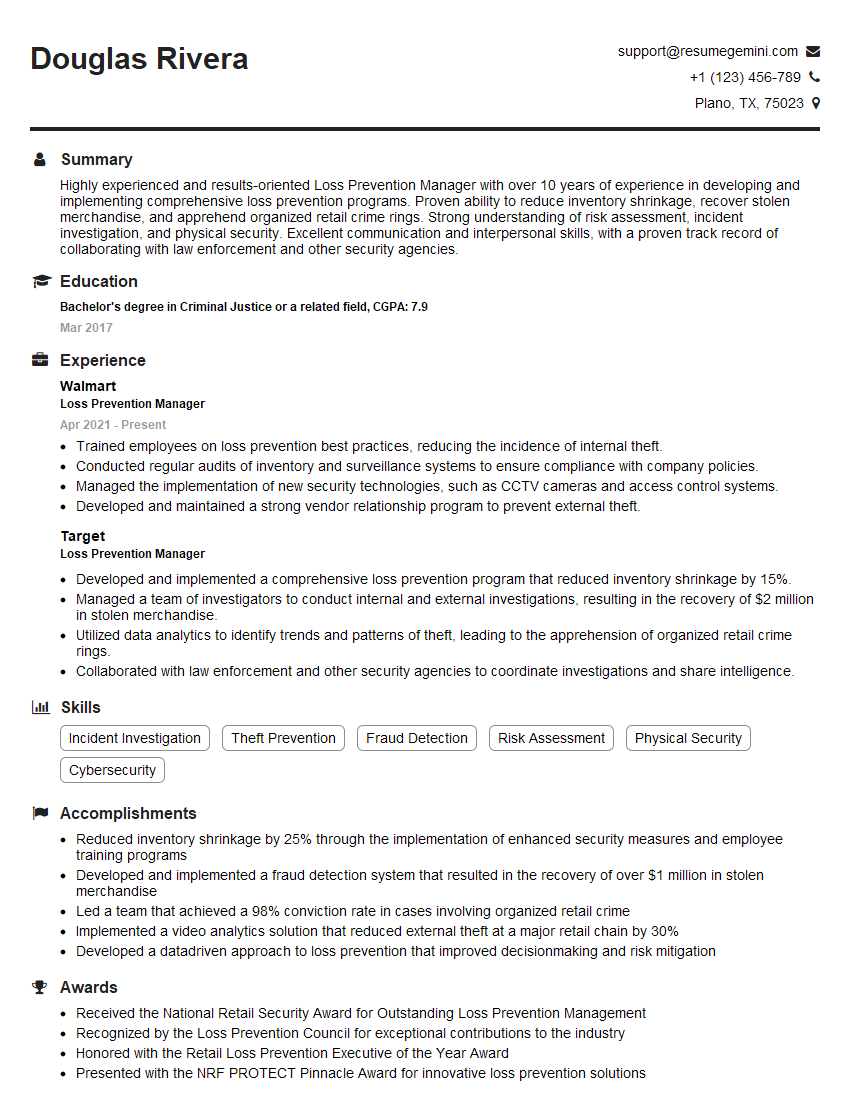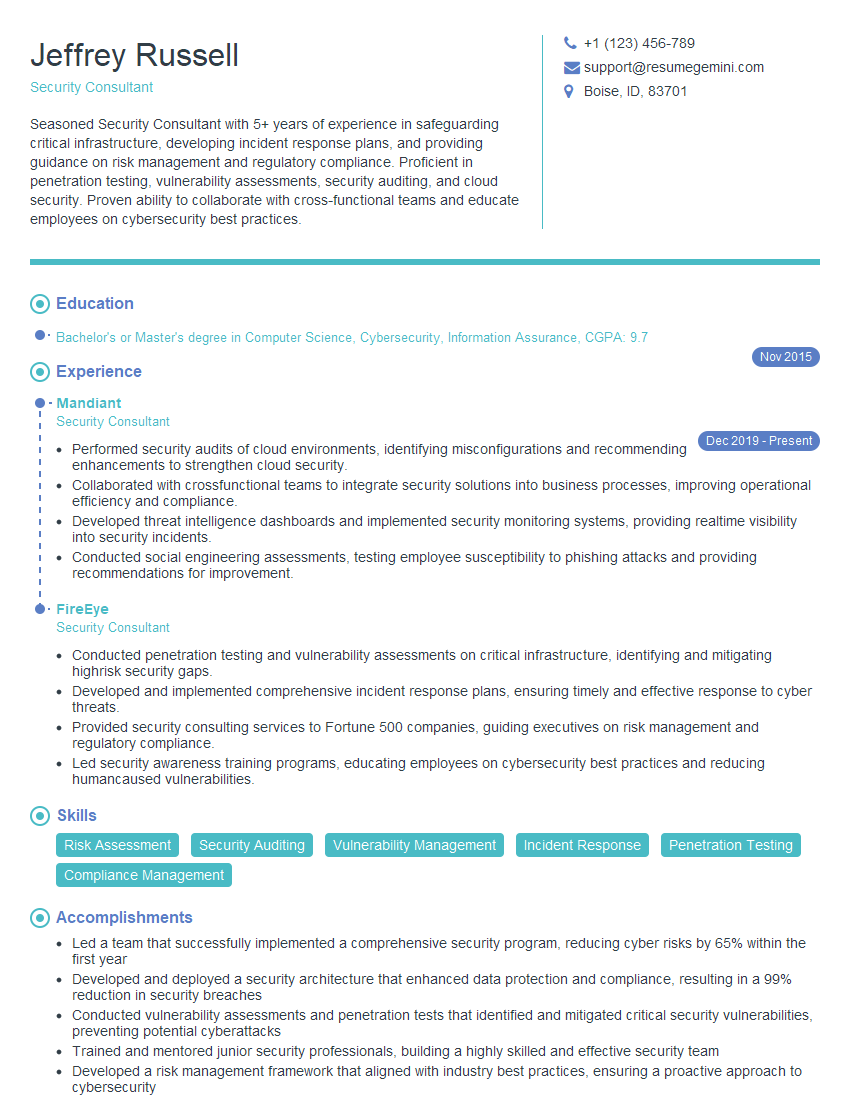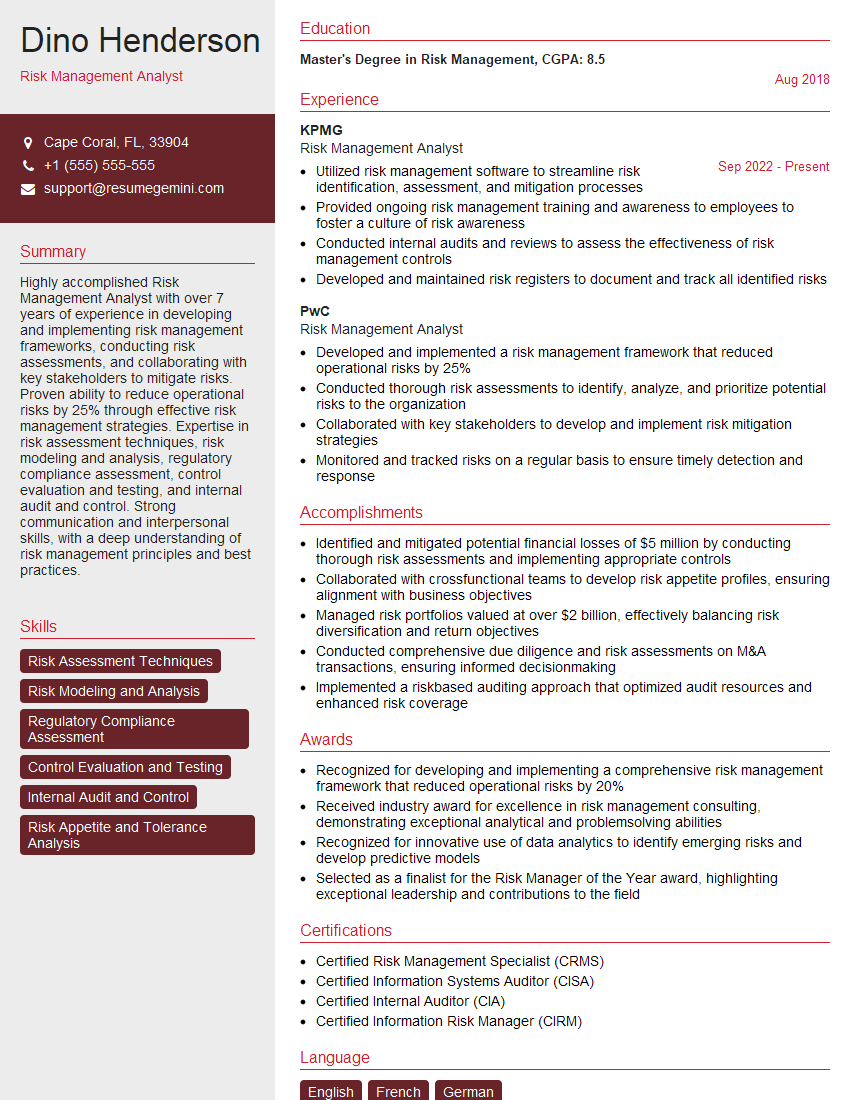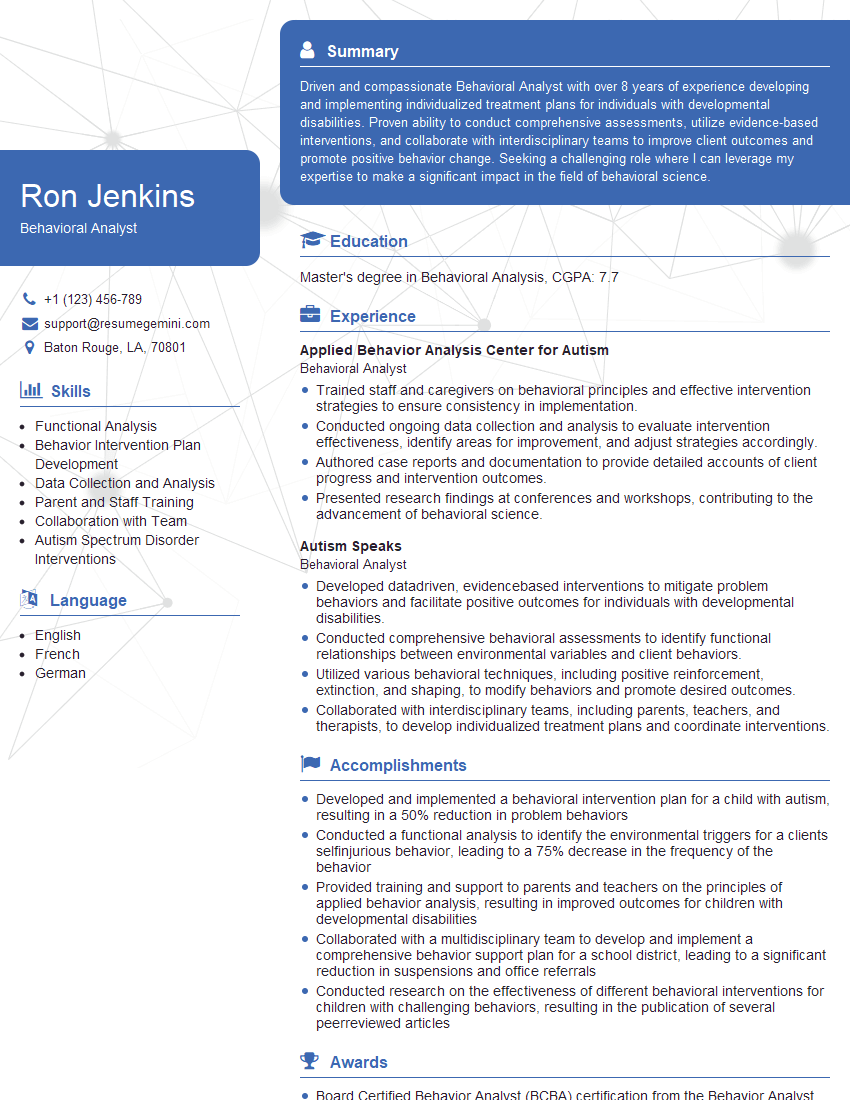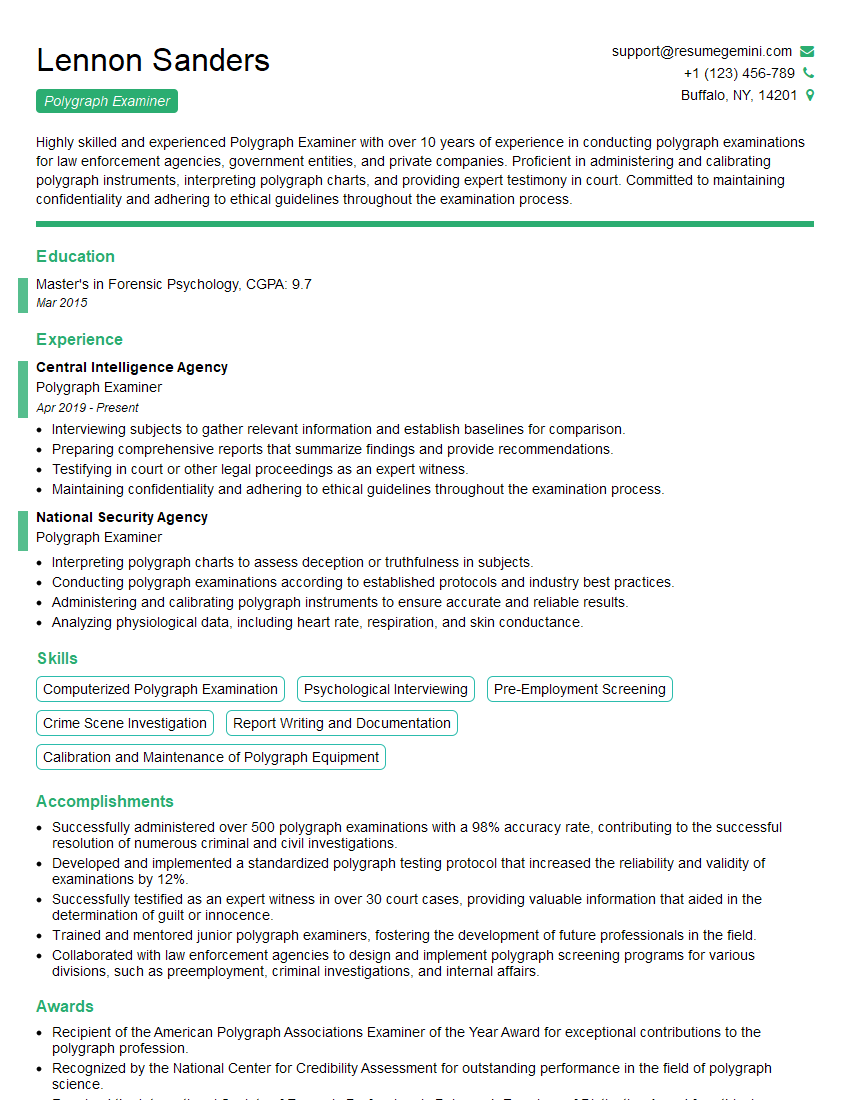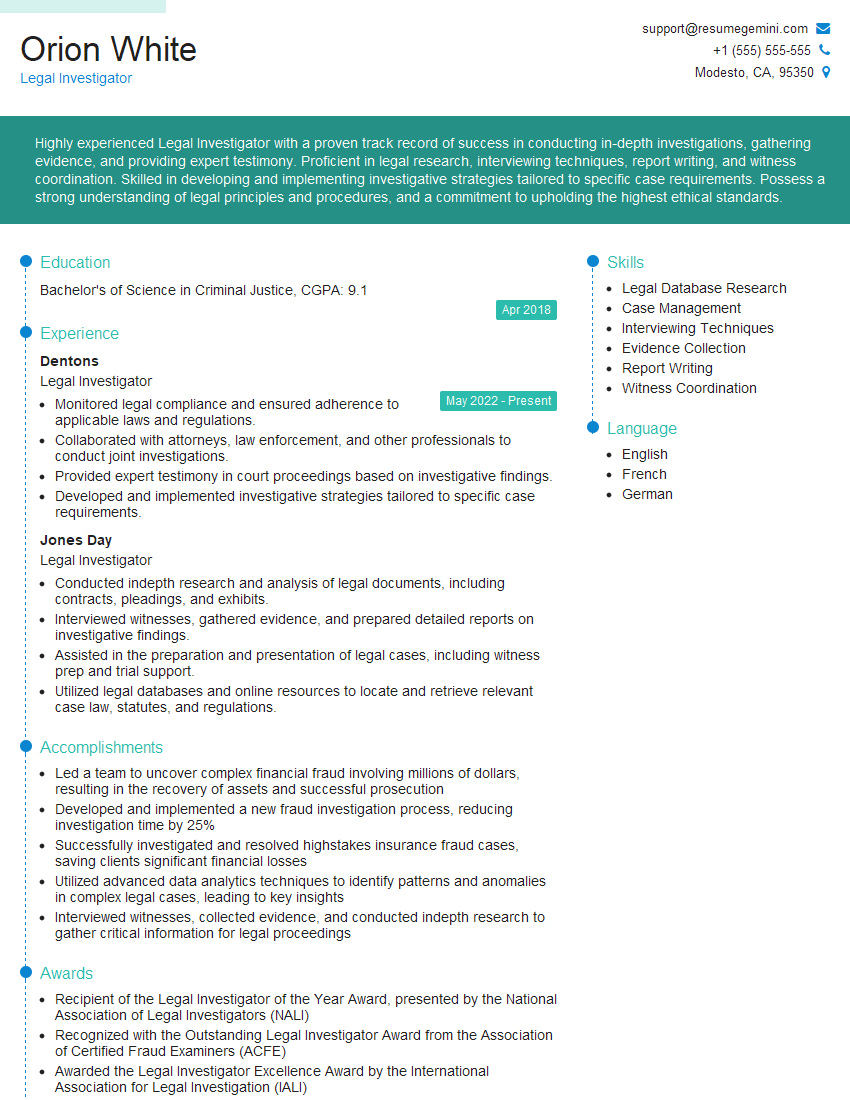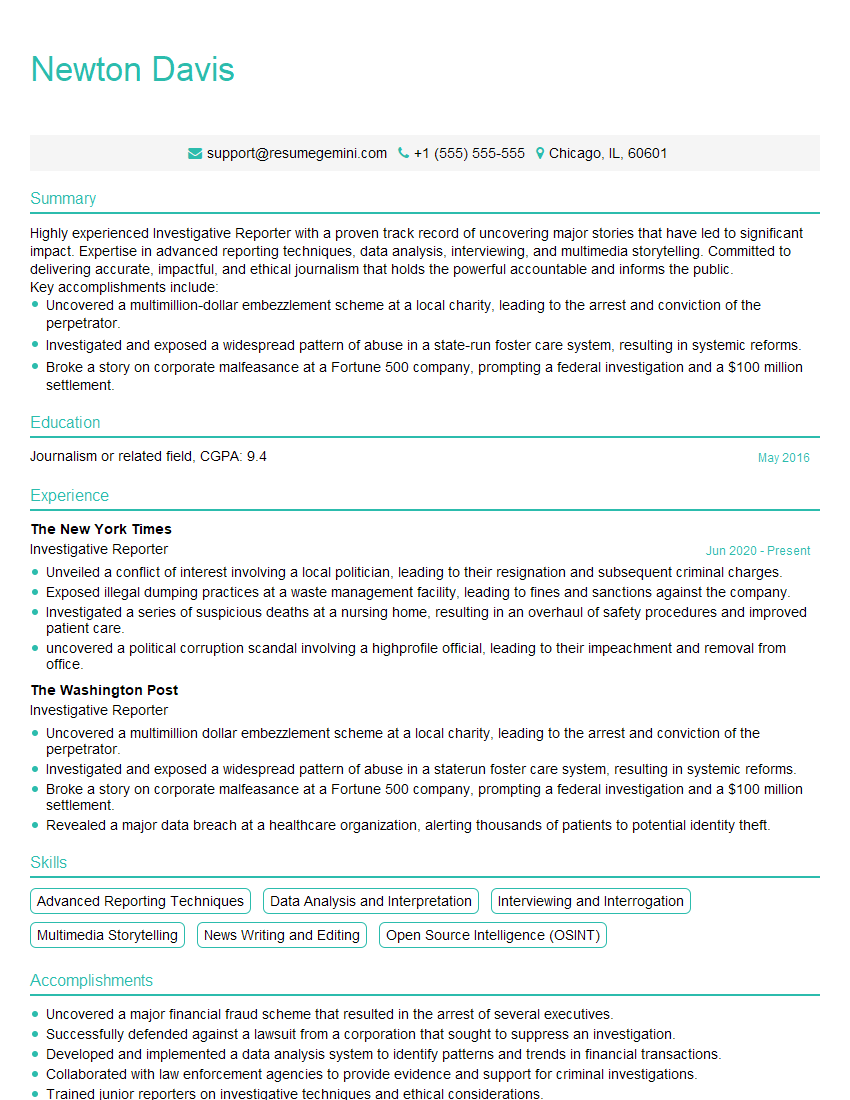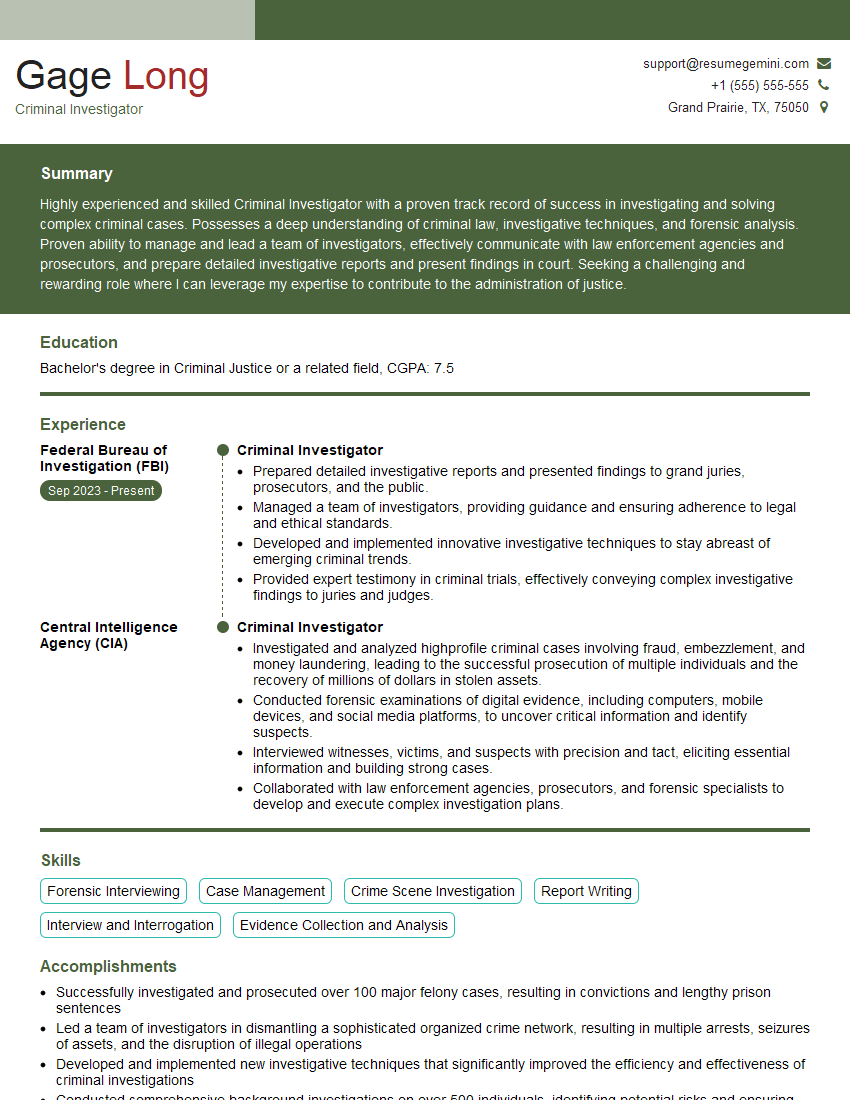The thought of an interview can be nerve-wracking, but the right preparation can make all the difference. Explore this comprehensive guide to Deception Detection interview questions and gain the confidence you need to showcase your abilities and secure the role.
Questions Asked in Deception Detection Interview
Q 1. Explain the difference between high-stakes and low-stakes deception.
The key difference between high-stakes and low-stakes deception lies in the potential consequences for the deceiver. In high-stakes deception, the potential penalties for being caught are severe – think of a criminal trial or a major corporate fraud investigation. The deceiver has a lot to lose. This often leads to more pronounced physiological and behavioral indicators of deception because the individual experiences higher levels of stress and anxiety.
Low-stakes deception, conversely, involves situations where the consequences of being caught are relatively minor, such as a small lie to a friend or a minor fib to avoid a social obligation. The pressure to deceive successfully is lower, often leading to less noticeable behavioral cues.
Imagine this: Lying about your whereabouts to a friend versus lying under oath in court. The first is low-stakes; the second, very high-stakes, and you’d likely show far more signs of deception in the latter case.
Q 2. Describe three common verbal indicators of deception.
Verbal indicators of deception are often subtle and require careful observation and analysis. Here are three common ones:
- Increased speech hesitations and pauses: Deceivers often take longer to respond, may stutter, or exhibit noticeable pauses in their speech as they construct their lies. This is because they are working harder to formulate a convincing narrative while simultaneously suppressing the truth.
- Overly precise or vague language: Liars might be either overly specific in their details (trying to appear credible) or overly vague (trying to avoid specifics that might expose their lie). A balance of detail is key to truthful communication.
- Inconsistencies in the narrative: Lies are hard to keep straight. As the liar retells the story, subtle inconsistencies, contradictions, or changes in the details may emerge. These discrepancies can be strong indicators of deception.
For example, if someone is asked about their alibi for a specific night and they initially say they were at home alone, but later recall a friend being present, this discrepancy warrants further investigation.
Q 3. Describe three common nonverbal indicators of deception.
Nonverbal cues are frequently cited as indicators of deception, but it’s crucial to remember that they are not definitive proof. Context and individual differences are critical. Here are three common nonverbal indicators:
- Microexpressions: These are fleeting facial expressions, lasting only fractions of a second, that can betray a person’s true emotions. For instance, a sudden flash of fear or guilt might contradict a verbal statement of innocence.
- Body language inconsistencies: A mismatch between verbal and nonverbal communication can be a significant red flag. For example, someone claiming to be calm might be exhibiting fidgeting, pacing, or avoiding eye contact.
- Changes in posture or demeanor: Shifts in posture, such as leaning away from the interviewer, stiffening up, or a significant change in their usual demeanor, can indicate discomfort or deception. A person’s typical baseline is important to consider.
It’s essential to note that these nonverbal cues are often influenced by factors like personality, culture, and the interview environment. A nervous person might exhibit similar behaviors to a deceptive one.
Q 4. What are the limitations of polygraph testing?
Polygraph testing, despite its popular portrayal, has significant limitations. Its accuracy is highly debated and depends heavily on several factors. Some key limitations include:
- Countermeasures: Individuals can consciously or unconsciously employ techniques to manipulate the results, such as biting their tongue or controlling their breathing.
- False positives and negatives: The test can incorrectly identify truthful individuals as deceptive (false positive) or deceptive individuals as truthful (false negative). This can lead to miscarriages of justice or incorrect conclusions in other contexts.
- Lack of standardization: There is no single, universally accepted standard for administering and interpreting polygraph tests. The expertise and methodology of the examiner greatly influences the results.
- Susceptibility to psychological factors: Anxiety, nervousness, and even the innocent fear of failing the test can influence physiological responses, making it difficult to accurately interpret the data.
In short, while polygraph results can offer some clues, they should not be treated as conclusive evidence of deception or truthfulness. They are best used as one piece of evidence among many.
Q 5. How do cultural factors influence deception detection?
Culture significantly influences deception detection. What might be considered a deceptive behavior in one culture could be perfectly acceptable or even expected in another. Cultural norms dictate appropriate levels of eye contact, personal space, and expressive behavior.
For example, in some cultures, direct eye contact is considered respectful and honest, while in others, it’s viewed as aggressive or disrespectful. Misinterpreting these cultural differences can lead to inaccurate assessments of deception. Similarly, certain nonverbal expressions might carry different meanings across cultures.
Effective deception detection requires cross-cultural awareness and sensitivity. Interviewers need to adapt their methods and interpretations to the cultural background of the individual they are interviewing. Ignoring cultural nuances can lead to significant biases and inaccurate conclusions.
Q 6. Explain the concept of ‘leakage’ in deception detection.
In deception detection, ‘leakage’ refers to involuntary displays of a person’s true emotions or thoughts that contradict their conscious attempts to deceive. These ‘leaks’ can manifest verbally or nonverbally. They are often unintentional and happen because it’s incredibly difficult to completely control all aspects of behavior and communication under pressure.
For example, a person might verbally deny involvement in a crime but unconsciously display a fleeting expression of guilt or fear. Or, they might maintain a calm demeanor but show inconsistencies in their narrative. These are examples of ‘leakage’ – small involuntary signals that the person is not being entirely truthful. It’s these subtle details that expert deception detectors are trained to identify and interpret.
Q 7. Describe different methods for calibrating baseline behavior during an interview.
Calibrating baseline behavior is crucial for accurately assessing changes in behavior that might indicate deception. It involves establishing a benchmark of the individual’s typical behavior during a non-stressful portion of the interview. Here are different methods:
- Initial small talk and rapport building: Before addressing sensitive topics, engage in casual conversation to observe the person’s natural demeanor, speech patterns, and body language.
- Controlled questions: Ask questions about neutral or readily verifiable information. These serve as a baseline for comparison when sensitive or potentially deceptive questions are asked later.
- Observation of spontaneous behaviors: Pay attention to the subject’s behavior during natural, unscripted moments of the conversation. This helps to identify their baseline mannerisms.
By establishing a clear baseline, interviewers can more accurately identify deviations in behavior that might suggest deception. It’s not about finding specific ‘tell-tale’ signs, but about observing patterns and changes relative to the individual’s established normal behavior.
Q 8. What is the strategic value of using open-ended versus closed-ended questions during an interrogation?
Open-ended questions, which encourage detailed responses, are strategically valuable in deception detection because they provide richer information than closed-ended questions (yes/no answers). They allow the subject to elaborate freely, revealing inconsistencies, hesitations, or details that might slip under scrutiny in a more controlled setting.
For example, instead of asking ‘Did you steal the money?’, a more effective open-ended question would be ‘Can you describe your actions on the day the money went missing?’ This prompts a narrative response, giving the interviewer a more comprehensive picture of events and providing more opportunities to observe verbal and nonverbal cues of deception. Closed-ended questions can be used strategically later to clarify specific points or confirm details already gleaned.
The advantage lies in the potential for revealing spontaneous verbal and nonverbal behaviors. A deceptive person might struggle to maintain a consistent narrative with an open-ended question, offering a chance to detect subtle shifts in demeanor, voice, or story inconsistencies that would be obscured by simple yes/no answers.
Q 9. Discuss the ethical considerations of deception detection.
Ethical considerations in deception detection are paramount. The potential for false positives (incorrectly labeling an honest person as deceptive) or false negatives (missing a deceptive person) is ever-present. Moreover, the methods employed can be psychologically manipulative, impacting the subject’s well-being and potentially causing long-term harm.
It’s crucial to respect the subject’s rights, ensuring they understand the process, have legal representation if needed, and are not coerced or unduly pressured. The interviewer should also be aware of their own biases and strive for objectivity. For instance, using leading questions or relying too heavily on intuition can lead to misinterpretations. The interviewer’s own emotional state could also influence the assessment, so maintaining professionalism and impartiality is crucial.
Recording interviews is recommended not only for accountability but also for review, allowing for a less biased reassessment of the information obtained. Transparency in the process is key to mitigating potential ethical violations.
Q 10. How can you mitigate confirmation bias when assessing deception?
Confirmation bias, the tendency to seek out information that confirms pre-existing beliefs, is a significant threat to accurate deception detection. To mitigate this, interviewers must consciously challenge their assumptions and actively seek out disconfirming evidence. This means actively looking for information that contradicts their initial suspicions, rather than simply focusing on details that support them.
Strategies include:
- Developing structured interview protocols: These guide the process, ensuring all relevant questions are asked regardless of initial impressions.
- Recording and reviewing interviews: This provides a detached perspective, allowing for identification of biases during the review process.
- Seeking peer review: Having another professional review the interview and findings can help highlight any biases or oversights.
- Using objective measures: Relying on verifiable facts and evidence instead of subjective interpretations of behavior.
Imagine investigating an employee suspected of theft. Instead of solely focusing on the missing item, one should also look into the employee’s work record, alibi, and any other relevant information, even if it doesn’t initially seem supportive of the accusation. This helps ensure a more comprehensive and unbiased assessment.
Q 11. Explain the Reid Technique and its criticisms.
The Reid Technique is a well-known, but highly controversial, interrogation method. It involves a series of steps, including building rapport with the suspect, presenting evidence, and then using accusatory questioning to obtain a confession. Crucial elements include minimizing the suspect’s perceived culpability and offering potential justifications for the crime, thereby making confession easier.
Criticisms of the Reid Technique include:
- High risk of false confessions: The coercive nature of the technique can lead innocent individuals to confess to crimes they didn’t commit, often due to psychological pressure and exhaustion.
- Lack of scientific validity: The technique’s claims regarding detecting deception through nonverbal cues are not consistently supported by research. Many nonverbal cues are ambiguous and can be misinterpreted.
- Ethical concerns: The manipulative tactics employed are considered ethically questionable by many experts.
While some aspects, like building rapport, are valuable, the technique’s overall coercive nature and lack of scientific backing have led to its widespread condemnation and calls for more ethical and evidence-based methods. The use of such methods has caused many wrongful convictions.
Q 12. How do you differentiate between deliberate deception and unintentional misinformation?
Differentiating between deliberate deception and unintentional misinformation requires careful analysis of the context, the individual’s demeanor, and the consistency of their statements. Deliberate deception involves a conscious attempt to mislead, often accompanied by nonverbal indicators of stress or anxiety, and inconsistencies in the narrative.
Unintentional misinformation, on the other hand, arises from mistakes, gaps in memory, or misunderstandings. Individuals providing unintentional misinformation often exhibit less stress and are more cooperative when inconsistencies are pointed out. Their narratives usually lack the deliberate fabrication and strategic evasiveness seen in deliberate deception.
Example: A witness giving incorrect details about a car’s color due to poor lighting (unintentional) versus a suspect intentionally providing a false alibi (deliberate). The key is to consider the individual’s overall behavior, narrative consistency, and plausibility of their explanation.
Q 13. What is the significance of context in interpreting nonverbal cues?
Context is crucial in interpreting nonverbal cues, as many behaviors are ambiguous and can be influenced by various factors beyond deception. A nervous posture might indicate deception, anxiety, or simply being uncomfortable in an interrogation setting. A lack of eye contact could be a sign of deception, shyness, cultural norms, or even visual impairment.
For example, clenched fists might suggest anger or deception, but could also be a result of cold weather or physical discomfort. Therefore, it’s crucial to consider the overall context: the surrounding environment, the individual’s personality, cultural background, and the circumstances of the interaction. Consider observing a cluster of behaviors rather than relying on a single isolated cue.
Analyzing nonverbal cues in isolation is unreliable. A comprehensive assessment involves considering the entire interaction and the contextual factors surrounding the communication.
Q 14. Describe the process of conducting a structured interview for deception detection.
A structured interview for deception detection prioritizes a systematic and objective approach. It avoids leading questions and focuses on obtaining comprehensive information through carefully planned questioning.
The process typically involves:
- Preparation: Gathering background information and formulating a detailed interview plan.
- Building Rapport: Establishing a comfortable atmosphere to encourage open communication.
- Information Gathering: Using open-ended questions to elicit detailed accounts of the events in question.
- Statement Analysis: Carefully reviewing the interviewee’s statements for inconsistencies, contradictions, and unusual linguistic patterns.
- Clarification: Addressing inconsistencies and obtaining further clarification.
- Conclusion: Summarizing the interview and documenting the findings. This includes explicitly stating the limitations of the methods used and the basis for any conclusions drawn.
The process needs to be thoroughly documented, allowing for independent review and avoiding any undue influence on the conclusions. It’s also critical to remember that nonverbal cues are just one piece of the puzzle. Verifying facts and corroborating evidence are essential for accurate assessments.
Q 15. How do you assess the credibility of a witness’s testimony?
Assessing the credibility of a witness’s testimony involves a multifaceted approach that goes beyond simply believing or disbelieving what they say. It’s about critically evaluating their statement considering various factors. We look for consistency in their narrative – are there discrepancies between their initial statement and subsequent accounts? Are there any inconsistencies with physical evidence or other witness testimonies?
We also consider the witness’s demeanor. Are they nervous or evasive? Do their body language and verbal cues align with their story? A nervous demeanor doesn’t automatically indicate deception, but it’s a flag to investigate further. We assess their memory – is their recollection detailed and accurate, or vague and inconsistent? We also look for biases or motivations – does the witness have a reason to lie or exaggerate? For instance, a witness who stands to gain financially from a particular outcome might be less credible. Finally, we scrutinize the witness’s ability to recall details. Strong recall of peripheral details often lends more credence, suggesting an authentic experience, compared to someone recalling only the central events.
For example, in a case of robbery, a witness who accurately recalls not just the thief’s appearance but also the type of car they drove and the street corner where they sped off from demonstrates a greater level of reliability than someone who only remembers the thief’s face.
Career Expert Tips:
- Ace those interviews! Prepare effectively by reviewing the Top 50 Most Common Interview Questions on ResumeGemini.
- Navigate your job search with confidence! Explore a wide range of Career Tips on ResumeGemini. Learn about common challenges and recommendations to overcome them.
- Craft the perfect resume! Master the Art of Resume Writing with ResumeGemini’s guide. Showcase your unique qualifications and achievements effectively.
- Don’t miss out on holiday savings! Build your dream resume with ResumeGemini’s ATS optimized templates.
Q 16. What are some techniques for managing your own biases during an interrogation?
Managing personal biases during an interrogation is crucial for obtaining accurate information. We achieve this through rigorous self-awareness and employing structured techniques. Firstly, I actively acknowledge my own potential biases, considering my background, personal experiences, and any pre-conceived notions I might have about the suspect or the case. This self-reflection helps me to maintain a more objective perspective. Secondly, I strive to maintain a neutral and empathetic approach, avoiding judgmental language and behaviors. I approach each interview with an open mind, aiming to gather factual information, rather than seeking to confirm pre-existing beliefs.
Structured interviewing techniques, like the PEACE model (Preparation and Planning, Engage and Explain, Account, Closure, Evaluation), help reduce bias. This structured approach emphasizes active listening, focusing on the suspect’s account, rather than leading questions or premature judgment. I also use techniques like detailed note-taking and audio/video recording to create a factual record of the interview. This allows for later review and analysis, reducing the influence of memory biases or emotional responses.
Finally, I regularly seek feedback from colleagues and supervisors, to ensure that my interviews are unbiased and professional. Peer review helps to identify any blind spots or unconscious biases that I might not have recognized independently.
Q 17. Discuss the use of technology (e.g., voice stress analysis) in deception detection.
Technology plays a significant role in deception detection, though it’s crucial to understand that no single technology definitively proves or disproves deception. While often portrayed in fiction as infallible, the reality is more nuanced. Voice stress analysis (VSA), for example, attempts to detect deception by analyzing subtle vocal changes believed to be associated with stress. The premise is that a person under stress, potentially from lying, will exhibit variations in their voice that are detectable by specialized equipment. However, VSA’s reliability is highly debated within the scientific community. Many studies have shown that it has a high rate of false positives and false negatives, rendering its results unreliable as sole evidence.
Other technologies, such as fMRI (functional magnetic resonance imaging) and EEG (electroencephalography), explore brain activity patterns associated with deception. While potentially promising, these techniques are expensive, time-consuming, and also subject to various limitations and ethical concerns regarding privacy. Furthermore, these technologies often fail to differentiate between various states of emotional arousal, such as nervousness and fear, that may not be related to deception. It’s crucial to remember that these technologies are tools to assist in the investigation, not definitive indicators of truthfulness or deception.
In practice, technological tools should be used in conjunction with traditional investigative methods like interviewing, observation, and evidence gathering. Relying solely on technological tools risks misinterpretations and can lead to unjust outcomes.
Q 18. How do you handle resistance or defensiveness during an interview?
Handling resistance or defensiveness during an interview requires patience, understanding, and a strategic approach. It’s crucial to remember that defensiveness is often a natural reaction, especially when individuals feel accused or threatened. Instead of confronting the resistance head-on, I attempt to establish rapport and build trust. I approach the interviewee with empathy and try to understand their perspective, acknowledging their feelings. Using open-ended questions and active listening, I allow them to express their concerns and feelings without interruption. This creates a more cooperative environment.
I also use tactical communication strategies. For example, I might reframe questions to be less confrontational or accusatory. Instead of asking ‘Did you steal the money?’, I might ask ‘Can you describe your whereabouts on the day of the incident?’. This less threatening approach often helps in gaining cooperation. If the defensiveness persists, I might pause the interview and return to it later, allowing the person time to calm down. In cases where cooperation remains difficult, it might be necessary to take a break and seek alternative approaches such as obtaining evidence or further investigation before resuming the interview.
A practical example: Imagine interviewing someone who is being investigated for workplace misconduct. If they immediately become defensive, I wouldn’t push them. I’d begin by saying something like, ‘I understand this situation is difficult, and I appreciate your cooperation.’ Then, I would shift to open-ended questions, allowing them to explain their actions in their own words before addressing specific concerns.
Q 19. Explain the concept of cognitive load and its relevance to deception detection.
Cognitive load refers to the amount of mental effort being used in the working memory. It’s the brain’s processing power at a given moment. In deception detection, understanding cognitive load is highly relevant because deception requires significant mental effort. A liar needs to create a believable story, remember the details, and manage their behavior to avoid detection. This added mental burden can manifest in various ways. For example, increased cognitive load can lead to longer response times, hesitant speech, less detail in their accounts, and an inability to provide spontaneous responses to unexpected questions.
Detecting increased cognitive load isn’t about looking for specific verbal or non-verbal cues but involves observing a pattern of behavior. For example, if someone answers simple questions effortlessly but struggles to answer follow-up questions related to the same issue, their cognitive load could indicate deception. Conversely, a truthful individual would typically maintain relatively consistent cognitive load throughout an interview, regardless of question complexity. We use techniques to increase a subject’s cognitive load during questioning. Asking unanticipated questions or requesting detailed accounts of events require more mental processing. This increase in cognitive load can help expose inconsistencies and increase the likelihood of revealing deceptive behaviors.
Imagine a suspect describing a robbery. If their account is vague, they struggle to recall details, and they hesitate when asked unexpected questions about the scene (e.g., the color of the victim’s shoes), this might suggest a higher-than-normal cognitive load, raising suspicion about their truthfulness.
Q 20. Describe different interviewing strategies for different personality types.
Interviewing strategies should be adapted to individual personality types to maximize cooperation and information gathering. There is no one-size-fits-all approach. Understanding an individual’s personality (e.g., introverted/extroverted, high/low agreeableness) helps tailor questioning styles. For example, an introverted individual might be more comfortable responding to written questions or in a quieter environment, minimizing distractions. It is important to be aware that forcing an introvert to answer quickly or participate in a highly interactive interview will likely result in less cooperation and less helpful information.
With extroverted individuals, a more interactive approach might be beneficial, encouraging them to elaborate on their answers and express themselves freely. Individuals with high agreeableness will be more likely to cooperate and offer assistance, while individuals with low agreeableness may require a different strategy, possibly focusing on establishing trust and understanding their motivations. In all cases, building rapport and demonstrating empathy remain essential regardless of personality type. The key is to build trust and ensure the person feels comfortable sharing information. A crucial step is to understand and appropriately react to non-verbal cues.
For example, I might use a more formal and structured approach with someone exhibiting a dominant personality, whereas with someone more submissive, I’d aim for a gentler and supportive approach. Flexibility and adaptability are vital for effective interviewing.
Q 21. How do you handle conflicting information from multiple sources?
Handling conflicting information from multiple sources requires a systematic and analytical approach. It’s not about simply choosing one source over another, but about evaluating each source’s credibility and identifying potential reasons for the discrepancies. This involves scrutinizing each source’s motives, biases, and opportunities for observation. Were all sources equally positioned to witness the events? Do they have any relationships with other involved parties that could bias their accounts? A thorough analysis helps to establish which accounts are more reliable.
I typically use a process of triangulation. This involves comparing information from different sources to find consistencies and inconsistencies. If multiple sources provide similar accounts, it strengthens the reliability of the information. Conversely, discrepancies require closer examination to identify the source of the conflict. Sometimes the conflict may result from differences in interpretation or memory limitations. It is important to gather further information to reconcile these differences. Further investigation, including reviewing physical evidence, or conducting more interviews, can help resolve inconsistencies.
For example, in a traffic accident investigation, if one witness claims the car ran a red light, while another claims it did not, I would investigate if one witness’s view might have been obscured. I would examine traffic light camera footage or look for additional physical evidence such as skid marks to determine the most probable scenario. It is important to remember that discrepancies don’t necessarily mean deception; they simply require further investigation to understand their root cause.
Q 22. What is your approach to building rapport with a potentially deceptive individual?
Building rapport with a potentially deceptive individual is crucial for eliciting truthful information. It’s not about gaining their trust blindly, but creating a comfortable environment where they feel less inclined to be deceptive. My approach is multifaceted:
- Active Listening: I focus intently on what they say, both verbally and nonverbally, showing genuine interest. This involves mirroring their body language subtly (not mimicking, but matching the general pace and posture) and using verbal affirmations like ‘I understand’ or ‘Tell me more’.
- Empathy and Validation: I aim to understand their perspective, even if I don’t necessarily agree with it. Acknowledging their feelings – even negative ones – can reduce defensiveness. For instance, I might say something like, ‘I can see this is a difficult situation for you’.
- Controlled Conversation: While fostering a conversational atmosphere, I maintain control of the flow of the conversation, asking open-ended questions and guiding it towards relevant information. I avoid accusatory language and steer clear from leading questions.
- Calibration: Before the ‘interview’ begins, I observe their baseline behavior – their usual demeanor, speech patterns, and body language – to establish a benchmark for comparison later. This helps in identifying deviations that might indicate deception.
Essentially, I aim to create a space where they feel heard and understood, which can make them more willing to be candid, even if inadvertently.
Q 23. Describe a situation where you successfully identified deception. What clues did you use?
During an internal investigation of a potential data breach, an employee consistently denied accessing unauthorized files. However, while describing their daily routine, their account contradicted established access logs. Specifically:
- Verbal Inconsistencies: They initially claimed they only accessed specific client folders, but later mentioned working on a project requiring access to a different, restricted server – a server the logs indicated they accessed numerous times outside regular working hours.
- Microexpressions: While denying access, I observed a fleeting microexpression of fear – a slight tightening of the muscles around their eyes – when I mentioned the specific files found on their login. These microexpressions lasted only fractions of a second, yet they were significant deviations from their usual calm demeanor.
- Body Language: Their initial relaxed posture shifted to become noticeably tense and stiff as I presented evidence of their unauthorized access. They also avoided direct eye contact and frequently touched their face.
The combination of these verbal and nonverbal clues, along with the digital evidence, strongly suggested deception. A subsequent confession confirmed the unauthorized access.
Q 24. How do you differentiate between deception and nervousness?
Differentiating between deception and nervousness is crucial, as nervousness can manifest in similar ways to deception. The key lies in observing the context and clustering of behaviors.
- Context: Is the individual nervous about the situation in general, or are they specifically nervous about answering particular questions? Nervousness is usually generalized, while deception is often tied to specific topics or questions.
- Clustering: Deception often involves a cluster of inconsistent behaviors – verbal inconsistencies, nonverbal cues like microexpressions, and body language shifts – all pointing towards a potential lie. Nervousness, while it can cause some of these behaviors, is less likely to display such a consistent and coordinated pattern.
- Duration: Nervousness might be present throughout the interaction, while deceptive behaviors are often concentrated around specific questions or topics.
For example, someone nervously fidgeting with their hands while discussing a mundane topic might just be anxious. However, the same fidgeting coupled with contradictory statements and averted gaze when questioned about a specific event would be more suggestive of deception.
Q 25. Explain the concept of microexpressions and their role in deception detection.
Microexpressions are fleeting facial expressions – lasting only a fraction of a second – that reveal a person’s true emotions, even if they’re trying to conceal them. They are involuntary and difficult to consciously control, making them valuable indicators of deception.
These expressions usually contradict the individual’s verbal statements or intended demeanor. For example, someone might verbally express happiness while a microexpression of sadness or anger briefly flashes across their face, suggesting a possible discrepancy.
The role of microexpressions in deception detection is significant because they provide a window into subconscious emotional responses. While not foolproof, observing microexpressions, especially when coupled with other behavioral cues, significantly improves the accuracy of deception detection. Specialized training is required to accurately interpret microexpressions, as subtle nuances are critical for proper assessment.
Q 26. What are the legal and evidentiary implications of deception detection techniques?
The legal and evidentiary implications of deception detection techniques are significant and complex. While behavioral analysis can be a valuable investigative tool, its use in legal proceedings is subject to strict limitations:
- Admissibility of Evidence: The admissibility of evidence derived from deception detection techniques depends on the specific jurisdiction and the reliability of the methods used. Expert testimony is often required to validate the techniques and their application.
- Bias and Subjectivity: Concerns exist regarding the potential for bias and subjectivity in interpreting behavioral cues. The accuracy of interpretation depends heavily on the experience and training of the observer, raising questions about the reliability of such evidence in court.
- Due Process: The use of deception detection techniques must always respect the rights of the individual being assessed. Coercion or deception in the process is unacceptable and can invalidate any evidence obtained.
- Polygraph Tests: Polygraph (lie detector) tests, while sometimes used, are often considered unreliable and inadmissible in many courts due to their questionable scientific validity.
In summary, deception detection techniques can be powerful investigative tools, but their use in legal settings must be approached cautiously, ensuring due process and relying on scientifically sound and properly validated methods.
Q 27. Describe your experience with conducting investigations involving financial fraud.
My experience in investigating financial fraud cases involves a multifaceted approach, combining behavioral analysis with financial forensic techniques. I’ve worked on numerous cases involving embezzlement, fraudulent accounting, and investment scams.
A common approach involves:
- Financial Statement Analysis: Identifying discrepancies and anomalies in financial records is crucial. I use specialized software and techniques to detect patterns of unusual transactions, missing documentation, or inconsistencies in reporting.
- Interviewing Suspects and Witnesses: Conducting structured interviews using techniques designed to elicit truthful information is a significant part of the investigation. This involves careful observation of verbal and nonverbal cues, along with the use of open-ended and clarifying questions.
- Document Review: Thoroughly examining relevant documents – contracts, invoices, emails, and internal communications – to find evidence of fraudulent activities.
- Data Analysis: Using data mining and other analytical techniques to identify patterns and connections between different pieces of evidence.
One particular case involved a senior accountant who was embezzling funds through shell companies. While they initially denied any wrongdoing, inconsistencies in their financial statements, along with observed behavioral cues during interviews (including microexpressions of guilt and evasive answers), led to a confession and recovery of a significant portion of the stolen funds. Success hinges on a combination of meticulous data analysis and insightful behavioral observation.
Key Topics to Learn for Deception Detection Interview
- Verbal and Nonverbal Communication Analysis: Understanding the nuances of body language, microexpressions, and vocal cues indicative of deception. Practical application: Analyzing interview responses for inconsistencies.
- Cognitive Biases and Heuristics: Recognizing common biases that can cloud judgment and lead to inaccurate deception assessments. Practical application: Developing strategies to mitigate personal biases during investigations.
- Statement Analysis Techniques: Mastering methods for analyzing the content and structure of verbal statements to identify potential deception. Practical application: Evaluating witness testimonies for credibility.
- Polygraph Interpretation (if applicable): Understanding the principles and limitations of polygraph testing, including chart analysis and interpretation of physiological responses. Practical application: Critically evaluating polygraph results in conjunction with other evidence.
- Ethical Considerations: Understanding the ethical implications of deception detection and the importance of responsible application of techniques. Practical application: Ensuring fairness and due process in investigations.
- Case Studies and Scenario Analysis: Applying theoretical knowledge to real-world scenarios. Practical application: Developing problem-solving skills and critical thinking abilities.
- Interviewing and Interrogation Techniques: Mastering effective questioning techniques to elicit truthful information and identify deceptive behaviors. Practical application: Conducting structured interviews to obtain reliable information.
Next Steps
Mastering deception detection opens doors to exciting and impactful careers in law enforcement, security, intelligence, and more. To maximize your job prospects, it’s crucial to present your skills effectively. Creating an ATS-friendly resume is key to getting your application noticed. We strongly recommend using ResumeGemini to build a professional and compelling resume that highlights your expertise in deception detection. Examples of resumes tailored to this field are available to guide you. Invest in your future – build a resume that showcases your talents and lands you that dream interview.
Explore more articles
Users Rating of Our Blogs
Share Your Experience
We value your feedback! Please rate our content and share your thoughts (optional).
What Readers Say About Our Blog
Interesting Article, I liked the depth of knowledge you’ve shared.
Helpful, thanks for sharing.
Hi, I represent a social media marketing agency and liked your blog
Hi, I represent an SEO company that specialises in getting you AI citations and higher rankings on Google. I’d like to offer you a 100% free SEO audit for your website. Would you be interested?

